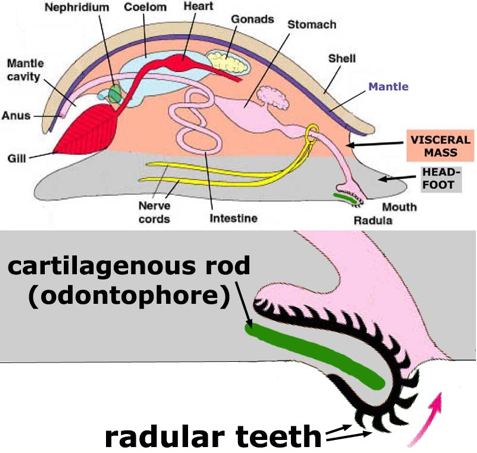Nutrition
Although there is not much information about the nutrition and feeding habits of Stenotrema barbatum specifically, there are some known details about pulmonate snails in general. Terrestrial snails are known as scavengers that tend to feed on detritus and decaying plant matter (Fretter & Peake, 1975). Inorganic materials such as soil and shell-building calcium minerals may also be consumed (Carnegie, 2005). The dietary guidelines of nutrition for land snails, such as necessary intake of fat, protein, and carbohydrates, are unknown at the time (Fretter & Peake, 1975). These pulmonates also have a selective diet, and may only feed upon one of these available food sources over a period of a few day (Fretter & Peake, 1975). This may be due to the fact that snails are so restricted in motility, or because they actually prefer one food over another for a few days at a time (Fretter & Peake, 1975).

The buccal mass is where the feeding structures
of pulmonates are located (Fretter
& Peake, 1975). This mouth region contains the
snail’s jaw, odontophore cartilage, salivary glands, radula, and some muscles (Fretter
& Peake, 1975). The radula is a region of firm
rows of teeth attached to a membrane which
is used for feeding (Fretter
& Peake, 1975). These chitinous
“teeth” are moved forwards and backwards along the
cartilage, breaking off small pieces of food to
begin digestion in the esophagus (Carnegie, 2005).
From that point, the food mixes with liquids that
aid in digestion in the gastric pouch. This mixture
eventually travels through the intestines to the
rectum, and the waste exits out of the anal pour (Carnegie,
2005).
Snails obtain some water through their food (Fretter
& Peake, 1975). However, most land snails absorb
moisture through their skin (Fretter
& Peake, 1975). Terrestrial land snails such
as Stenotrema barbatum have an open
circulatory system(Fretter
& Peake, 1975). This type of
circulatory system is a characteristic of all
mollusks except cephalopods (Encyclopedia
of Life, 2013).
Click here to learn about how Stenotrema barbatum reproduces.
